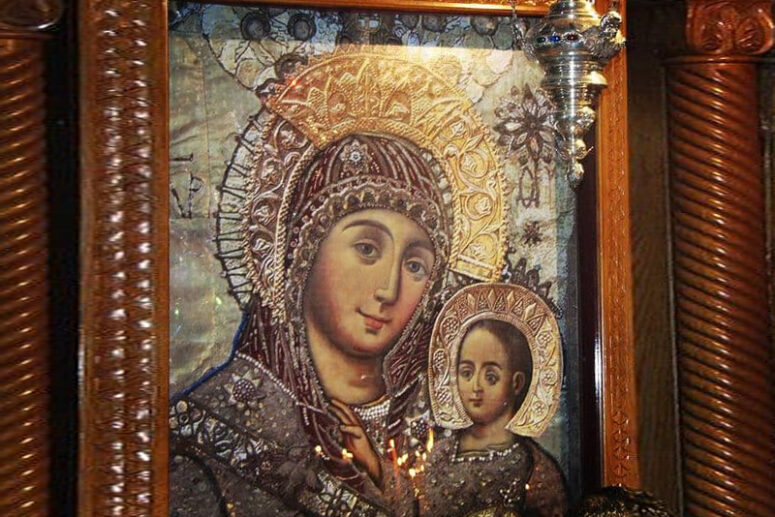
The icons of the Most Holy Theotokos have always been revered by the Orthodox Christians with particular ardency. There are many different images of the Mother of God, located in various parts of the world. Each of them has its own history and its own iconographic particularities. However, among all images of the Most Pure One this one stands out with a truly unique detail — the smile on Her Most Holy Face. What do we know about this icon today?
Origin
The prototype of the “Bethlehem” Mother of God is generally believed to have been written by St Luke the Evangelist during the life of the Most Holy Theotokos. Once, the Apostle brought to the Most Pure One three portraits depicting Her, which were not quite canonical. The Mother of God liked one of the images, showing Her smiling as She was holding the Divine Baby in her arms. The Queen of Heaven blessed the icon and said that everyone who sincerely prayed before it would receive the grace of God.
Unfortunately, the further history of the prototype is still unknown.
The Modern Miraculous Image
According to the most widespread version, the modern Bethlehem icon of the Mother of God comes from Russia. The image of the Most Holy Theotokos was ordered by the family of Emperor Nicholas II as a Christmas present for the Basilica Church of the Nativity in Bethlehem. According to legend, Princess Elizabeth Feodorovna was then healed of a serious illness through her prayers to the Mother of God in front of that icon. The grateful Grand Duchess gave a part of her dress and jewellery to decorate the plating of the Bethlehem icon of the Mother of God. The future great martyr personally handed the finished miraculous icon over to the Church of the Nativity. The Elisabeth-Sergius Educational Society, however, provides no confirmation of this version.
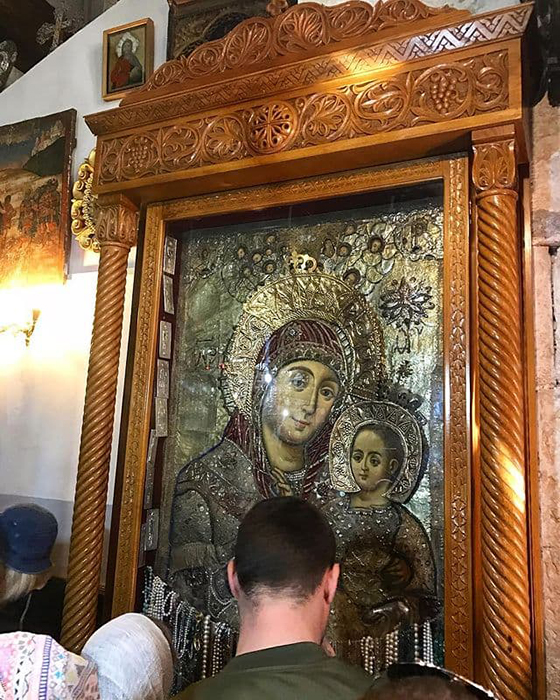
Restorers suggest that the icon presently located in Bethlehem was painted rather at the end of the 18th century and possibly not in Russia. It is argued that the present Bethlehem image was kept in the altar of the Holy Sepulcher Church Catholicon (Jerusalem) until 1808, when a severe fire hit the temple, causing two of the rescued shrines (the Great Crucifix and the “smiling image” of the Mother of God) to be transferred to Bethlehem. After the consequences of the fire were eliminated, the Crucifixion returned to its original dwelling place alone, while the icon of the Mother of God “took root” in the Church of the Nativity of Christ.
One way or another, the Bethlehem icon has left the Holy Land only once since the 19th century. It happened in 2010, when the shrine was brought to Kiev for the festive Easter service, together with the Holy Flame. Undoubtedly, such a miraculous event could only happen by the will of the Mother of God and the mercy of God Himself shown to the Orthodox believing Christians of Ukraine, wishing to pray and bow before the Queen of Heaven.
Some Famous Miracles Known Today
The Bethlehem icon of the Mother of God became regarded as miraculous after testimonies began to appear bearing witness to various miracles happening after prayers before it and also to the icon itself. People pray in front of the image of the Most Pure One asking for healing, family well-being and fertility. The large quantities of jewellery that, by tradition, the faithful leave near the icon frame, serve as a sign that the “smiling image” of the Mother of God really does help many.
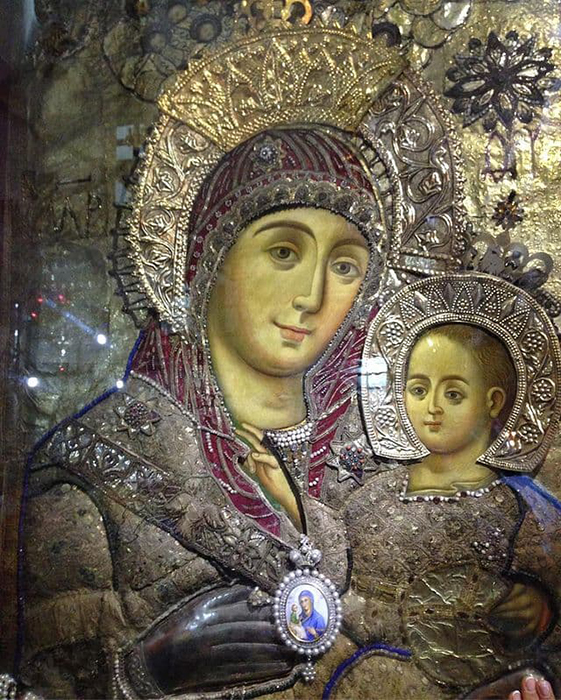
Unfortunately, only a few miracles connected with the Bethlehem image are recorded.
In the 1920s the holy image of the Mother of God warned Christians of the earthquake that was about to strike the Israeli lands. The oil-lamp burning in front of the icon had then been pendulating by itself for several days until the powerful blows shook the earth.
Contemporaries also testify to repeated cases when tears appeared in the eyes of the Infant Savior depicted on the Bethlehem Icon of the Mother of God.
It is noteworthy that in Bethlehem this icon of the Theotokos is revered not only by Christians, but also by Muslims. A story has been preserved (albeit without exact dating), which happened to certain Greek Orthodox monks. It happened on Great Monday, as they were standing at the Bethlehem Church of the Nativity of Christ. An agitated Muslim suddenly approached them and shared that the day before in a dream he was honored with the vision of the “Holy Mother”. The Mother of God invited him to visit the place where She gave birth to Her Son. She showed him the way into that very cave through a low passage and told him where to find Her miraculous image. With tears in his eyes, he was lighting candles in front of the Bethlehem icon of the Mother of God, saying that the icon of the Most Pure Virgin and everything else in the cave was exactly as it had appeared in his dream. After fulfilling the order of the Mother of God, the Muslim said goodbye to the monks and left. He did not know how much of a consolation his message from the Queen of Heaven was to these fathers, strengthening them in faith that “Her Son will come again and gather all who are close to Him.”
The Icon Composition
The Bethlehem icon belongs to the Hodegetria type (from the Greek “Guide” or “Pointing the way”). The image depicts the Most Holy Theotokos holding the Infant Christ at Her left arm and pointing to Him with Her right hand, as the Way of salvation for Christians. The Divine Infant has an orb in His left hand, symbolizing royal power. With his right hand He blesses those who pray before the icon of His Most Pure Mother.
A distinctive feature of the holy image is undoubtedly the soft, smiling face of the Virgin, emanating infinite radiance. This is the only image showing the Queen of Heaven in a state other than appeasement, austerity or sorrow. The smile on Her face comforts us and shows that there is no contradiction between holiness and the joy of life. The affection and warmth flowing from the gentle, kind glance of the Mother of God give every believer hope for Her help and intercession before the throne of the Most High.

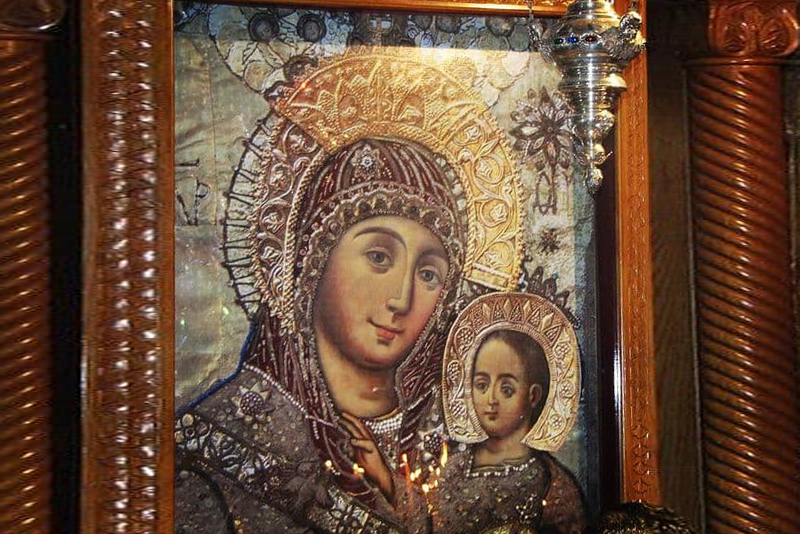

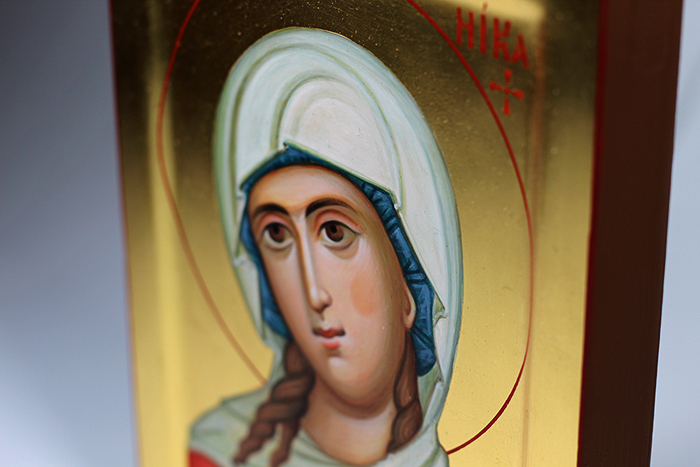
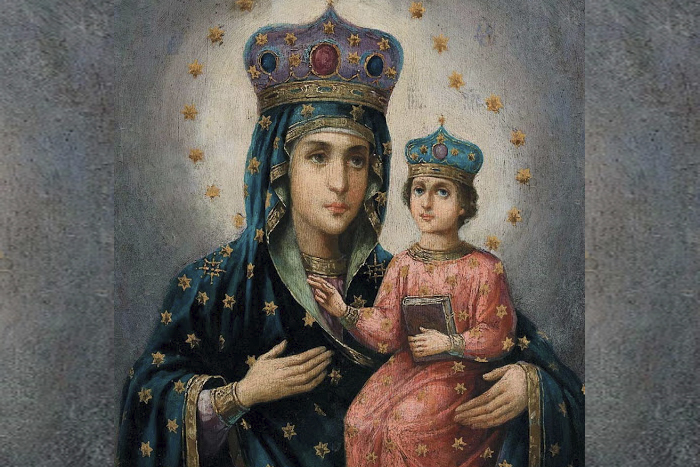
Un très grand Merci pour votre article, bien documenté.
Je reviens moi même de Palestine (15 mars 2023) où j’ai pu contempler cette icone … qui m’a happé !
Elle est toute en contraste … & désarçonne !
Il y a quelque chose EN elle, une force … & de la douceur,
Les regards dégagent aussi une certaine humilité, en contraste avec toute la richesse & les scintillements alentours.
Que de beauté !